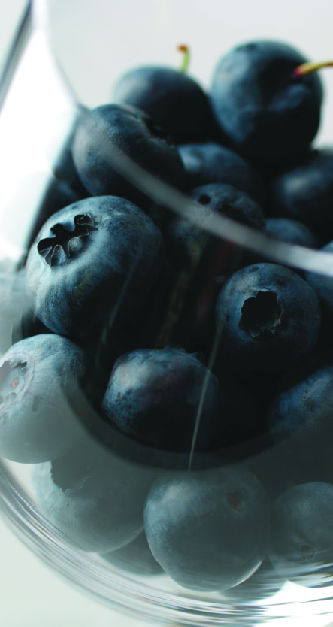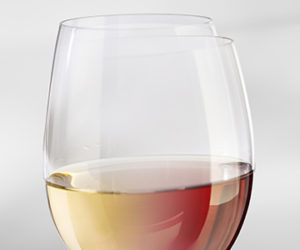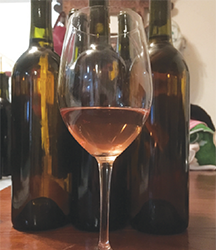
Americans love the taste of blueberries, and with good reason. Blueberries are uniquely American. Maybe that’s why I always think about blueberry wine when summer rolls around and I start planning Fourth of July backyard barbecues — good friends, good food, and best of all, good wine.
Native to North America, blueberries were popular with Native Americans and became doubly so when European settlers sampled the lovely layers of taste in the blueberries they found growing wild. Today cultivated blueberries grow in more than 30 states, as far north as Canada and as far south as Texas. The second-most popular fruit in the United States, fresh blueberries are easily found at fruit stands and supermarkets for nearly eight months of every year, but they are at their peak in July.
One of only three types of berries native to North America, blueberries — also known as bilberries, whortleberries and hurtle berries — come in four main varieties: highbush, rabbiteye, southern highbush, and wild or lowbush blueberries. You can find huge, fat blueberries in Michigan, smaller and slightly tarter blueberries in Vermont and tiny, flavor-packed berries in Maine.
Highbush blueberries, which grow up to ten feet tall, are the most common commercially available blueberries; in fact, 95 percent of commercial blueberries are of the highbush variety. They grow mostly in the northern United States and southern Canada. Georgia is one of the largest producers of rabbiteyes and southern highbush varieties. The lowbush, or wild blueberry variety common in Maine and Canada, was first noted by Captain James Cook in the late 1700s.
Selecting the Best Berries
Although blueberries are available in many forms, including fresh, canned, dried and puréed, winemakers should use freshly picked berries, preferably those they pick themselves. Fresh blueberries are at their flavorful best and have the highest acid content, which adds sparkle and freshness to the wine’s flavor and improves its keeping qualities. If you can’t pick your own — either from backyard bushes or a pick-and-pay fruit farm — premium fresh blueberries can be purchased from the supermarket.
Here’s what to look for when evaluating already picked berries: Choose berries that are deep blue with a translucent silver coating. Avoid berries that are green or have a red tinge. Make sure the berries are plump, firm and packaged in dry containers with no evidence of juice stains. Juice stains on the container indicate that the fruit is past its prime. Then smell the container and choose only those which smell like the essence of blueberry, with no off-odors. Once you’ve picked out the berries, be sure to use them quickly. Blueberries begin deteriorating seven to ten days after being picked — and you need to factor in the time it may have taken for them to reach the point of sale.
Developing Your Own Recipes
When you make blueberry wine, the amount of fruit you’ll use can vary from 2.5 to 5 pounds per gallon of wine, depending on the kind of wine you want to make and the amount of fermentable sugar you wish to derive from the fruit. Choosing higher volumes of fruit will result in a more pronounced blueberry flavor, but it will also increase the cost of your wine.
Oftentimes, it is just as easy to use fewer blueberries and make up for the decrease in fermentable sugars by using other ingredients. For example, instead of using blueberries and adding sugar, you could replace or augment the sugar with honey. The result will be a more complex wine that not only has the flavor components of the blueberries, but also subtle undertones of honey. Some winemakers create more complex wines by adding other fruits, such as blackberries or cherries. Some add spices such as cinnamon, or toss in a bit of lemon or orange peel for a citrus note.
It is important when making blueberry wine that you treat the wine with pectic enzyme. Blueberries are high in pectin, making them desirable for producing blueberry jam or jelly, but can result in cloudy wine. Pectic enzyme breaks the fruit’s natural pectin into simple, fermentable sugars so that the final wine is clear and free from pectin-induced cloudiness. Pectic enzyme is readily available where winemaking supplies are sold.
In addition, pay attention to the acid content of your wine. The longer blueberries are off the bush, the lower their acid content. If you are using blueberries purchased from a supermarket for winemaking, assume that you will need to add acid blend to the wine to maximize its flavor and preservative qualities. Acid blend is a mixture of citric, tartaric and malic acids commonly found in fruits. Acid blend gives your wine a touch of tartness and enhances its freshness. You can substitute 1 tablespoon of lemon juice for the acid blend if you prefer.
Regardless of what you use to increase your acid content, you are shooting for a pH between 3.8 and 3.4. This can be easily checked with litmus papers, sometimes called pH strips. For a more accurate reading, you should use a titration kit to check the acid. A reading of around 0.65 to 0.70 percent tartaric is desired. Either of these items can be found at any home winemaking shop. Remember: More acid can be added after fermentation for a final tweak, but it is very hard to reduce the acid with any degree of success.
Blueberry wine is also a prime candidate for oak aging. If you have an oak barrel, great! If not, you can achieve splendid results by using oak chips, preferably toasted. Just add the chips to the wine after fermentation. I would recommend 1/2 ounce (1/8 cup) per gallon. Taste the wine every few weeks to see how it is doing.
You should notice the wine becoming less harsh and gaining the added complexity of wood. The longer you wait, the more distinct the wood impression becomes. Take the chips out whenever it suits your tastes. Some of the woody character will diminish with further aging.
“Claret” Blueberry Wine
A claret-style wine is similar to a dry red French wine with a fruitier taste and aroma. Natural tannins from the skin of the blueberries give this wine the characteristic “pucker” that’s typical of dry wines.
This wine will go quite well with grilled chicken in addition to beef and pork. This recipe yields 1 gallon (3.8 liters) of wine. The starting gravity will be 1.090 to 1.100 and the potential alcohol is 12 to 13 percent.
Ingredients
3 pounds (1.4 kg) fresh blueberries (2 quarts)
1.5 pounds (680 g) sugar
3 quarts (1.5 liter) boiling water
1 teaspoon (5 g) acid blend
1 cup (237 mL) red grape concentrate (Zinfandel works well)
1 teaspoon (5 g) pectic enzyme
1 cup (237 ml) orange juice
1 (5 to 7 g) package red wine yeast (Pasteur Red works well)
1 Campden tablet
Step by step
1. Sanitize all equipment.
2. Place the blueberries and sugar into a two-gallon (7.6 liters) primary fermentation vat. Crush berries using a potato masher.
3. Add three quarts of boiling water, acid blend and red grape concentrate. Cover the container with a clean towel.
4. Let mixture cool to approximately 75° F (24°C). Then add the pectic enzyme.
5. Mix the wine yeast and the orange juice in a sanitized one-quart jar and let stand until mixture is bubbling (approximately one hour). Then add it to the cooled blueberry must.
6. Loosely cover the primary fermentation vessel with plastic or a towel and store in a warm place.
Stir the must twice daily using a sanitized, long-handled plastic spoon. Let the primary fermentation continue for seven days.
7. After seven days, strain the solids from the must using a sanitized straining bag or a sieve. Rack into a sanitized one-gallon fermentation vessel and top off with cold water. Attach a sanitized fermentation lock to the fermenter.
8. Rack the wine after ten days. Top off with cold water.
9. Let wine stand for 60 days. Rack and top off with water.
10. Let stand for 10 more days, rack, add 1 Campden tablet, and bottle. Bottle age for three to six months before drinking.
Dessert Blueberry Wine
This recipe makes a sweet, full-bodied dessert wine with good legs and tremendous sweet blueberry flavor. You can turn this fruit wine into an elegant cordial by adding a cup of good quality brandy to a standard-size wine bottle and topping off the bottle with blueberry dessert wine.
The port-style wine yeast in this recipe helps give the wine some of the characteristics of a classic port dessert wine. Many winemaking supply stores carry this type of yeast, and it can also be found on the Internet, but any red wine yeast can be substituted with good results. This recipe yields 1 gallon (3.8 liters) of wine. The starting gravity will be 1.125 and the potential alcohol is about 14 percent.
Ingredients
4 lbs. (1.8 kg) fresh blueberries (approximately 3 quarts or 1.8 kg)
1.5 lbs. (680 g) sugar
1 lb. (454 g) clover honey
3 quarts boiling water (1.5 liter)
1 teaspoon (5 g) acid blend
1 teaspoon (5 g) pectic enzyme
1 cup orange juice (237 mL)
1 package (5 to 7 g) port-style wine yeast
1 Campden tablet
Step by step
1. Sanitize all equipment.
2. Add honey and water to a stainless steel, glass or enamel pot. Bring the honey-water mixture to a boil, skimming off any foam that rises to the top.
3. Place blueberries and sugar into a two-gallon (7.6 liter) primary fermentation vat. Crush berries using a potato masher.
4. Add the honey and water mixture. Add acid blend and cover with a towel.
5. Let mixture cool to approximately 75° F (24° C). Add the pectic enzyme.
6. Mix the wine yeast and the orange juice in a one-quart jar and let stand until mixture is bubbling (approximately 1 hour). Then add to the cooled blueberry must.
7. Loosely cover the primary fermentation vat with plastic or a towel and store in a warm place.
8. Stir the must twice daily using a sanitized, long-handled plastic spoon. Let the primary fermentation continue for seven days.
9. After seven days, strain the solids from the must using a sanitized straining bag or a sieve. Rack into a sterile one-gallon container and top off with cold water. Attach a sanitized fermentation lock.
10. Rack the wine after ten days. Top off with cold water. Let wine stand for 60 days. Rack and top off with water.
11. Let stand for 10 more days, rack, add Campden tablet and bottle. Bottle age for three to six months before drinking.
You’ll probably want to test your blueberry wine in clear crystal wine glasses to enjoy the lovely color, but don’t forget the other uses for this all-American beverage. Blueberry wines make delicious wine coolers mixed with lemon-lime soft drinks, and they are equally good as a component of marinades and glazes for Fourth of July barbecues.







